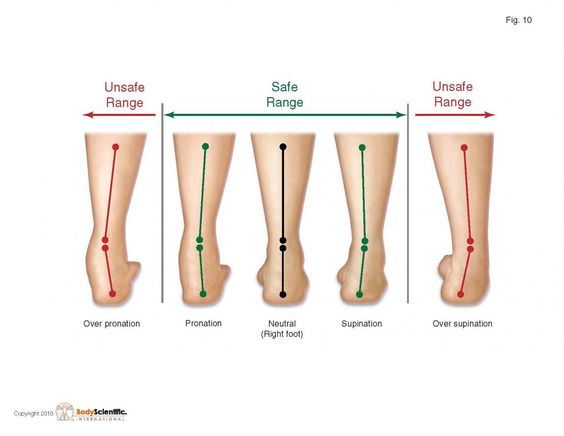Do you go to the shoe store and get overwhelmed by the many choices? Do you often choose shoes based on how they look, only later to realize they hurt your feet?
Debbie came to me after a two-week trip to Israel with an acute case of achilles tendonitis. She told me that she did an extensive amount of walking, wearing a new pair of cute, gym shoes. I looked at Debbie’s shoes; they were designed for an underpronated foot, otherwise known as a neutral shoe. Debbie’s evaluation showed that her feet overpronated when she walked, so she was wearing the wrong shoes for her foot type and, as a result, ultimately became injured.
The 3 types of shoes for walking/running
A good pair of walking/running shoes are organized into 3 categories:
- Neutral: A neutral shoe is designed for a person whose feet under pronate or pronate optimally
- Stability: A stability shoe is designed for a person whose feet over pronate.
- Motion Controlled: A motion controlled shoe is for a person who has poor ankle and foot control related to weakness, disability, or pathology such as neuropathy or diabetes.
To understand these terms, it’s good to know a little anatomy as well as how your foot works when walking/running.
Understanding the basics of foot & ankle anatomy

Your foot and ankle are a complex mechanism made up of 28 bones, 30 joints, and more than 100 muscles, ligaments and tendons that work together to provide stability, balance, and mobility. As you step forward, your foot is in a supinated, rigid posture as the outside of your heel hits the ground first. Your foot then pronates and becomes flexible as it moves to the inside of the heel, then your arch, and ultimately rolling over your big toe to begin another step. The rest of your body works together with your feet to move you forward and keep you stable.
What does a supinated, rigid foot posture mean? The subtalar (ankle) joint turns inward as the mid-foot engages the foot arch creating a rigid structure.
What does a pronated, flexible foot posture mean? The subtalar (ankle) joint turns outward as the mid-foot/arch flattens and becomes flexible.
How your foot works determines your shoe type
At The Manual Touch, we watch you walk todetermine your shoe type. But what are we looking for?
- Do you overpronate? If so, you need a stability shoe
- Do you underpronate or optimally pronate? If so, youneed a neutral shoe
- Do you skip the supinated, rigid foot posture completely? If so, you need a motion controlled shoe

Some people’s feet look like they are pronating because their arches collapse, but the subtalar (ankle) joint is not over-pronating. This means their mid-foot is too flexible and weak. The professional who is evaluating you should differentiate whether the subtalar (ankle) joint is actually over-pronating or if the mid-foot is collapsing. This foot type may do well with either a stability or a neutral shoe. Your professional can determine which shoe will be better for you by watching how your body responds to the shoes while you are walking in them.
Here are some tips/tests to determine your shoe type
When shopping for new shoes:
- Determine what you plan to use your shoes for — running, walking long distances, only for errands, exercise class, etc.
- Go to a specialty shoe store with salespeople who are trained to determine what foot type you are. In other words, they should watch you walk without shoes on. Some stores even do a 3D analysis of your foot to better match a shoe brand with your foot
- Be prepared to spend anywhere from $100 – $200. Your feet and comfort are worth every penny!
When trying on new shoes, ask yourself:
- Do they feel good when walking around the store?
- Can you wiggle your toes? Do your toes feel like they have “breathing room”? Better to have a larger size than too small
- Does your heel stay in the shoe or is it slipping?
- Can the shoes be laced a variety of ways to improve comfort?
- Can you stand on one leg easily?
Tips especially for runners
If you’re a runner testing out new running shoes, you should be able to pass these tests with ease and good neuromuscular control:
- Stand on one leg and…
- Raise your leg out to the side
- Bring your leg across
- Reach your leg towards the inside of your foot – watch this video
- Close your eyes
- Forward lunge without your knee collapsing in
- Run on the treadmill in the store – do they feel good?
- Determine the return policy after running in the shoes for 2-3 weeks
- Have your running analyzed by a physical therapist with your new shoes, to determine if the shoes are doing their job with the rest of your body – not just your feet
When I recommend a shoe type, I always provide this caveat: the shoe type recommendation is a starting point. Sometimes the patient will feel better and their body will respond better in a different shoe type, and that’s okay!
Anyone who has had foot pain will tell you how limiting it is and how wonderful the right pair of shoes can feel – no matter the cost. I hope this helps take the mystery out of buying shoes so you can feel good walking or running.
Want some help?
If you’re wondering if your shoes are ideal for you, feel free to set up a quick visit to determine the appropriate shoes for you.
For more information, visit my running services page.







Leave a Reply